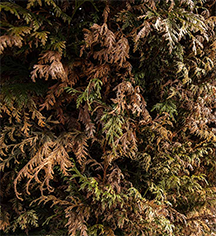What I’m Seeing This Spring of ’23
I am writing during the first full week of spring 2023, thinking about the extremely mild winter we just had, which hopefully is in the rearview mirror now. We had several snow events in March, all proceeded by warm weather that melted the snow each time rather quickly. The ground never did freeze this winter, which was great for evergreen trees and shrubs that benefited from every rain or snow event. When the ground freezes solid, evergreens are unable to absorb moisture and causes winter kill.
 As I drive around town, I notice brown evergreens, but this was caused by severe drought conditions last year, not winter burn. Drought stress shows up one to two years after droughts occur. When trees stop conducting moisture from the ground during drought conditions, it is very common to see bark lifting off from the tree trunk a year or two later, particularly on trees like Japanese maples.
As I drive around town, I notice brown evergreens, but this was caused by severe drought conditions last year, not winter burn. Drought stress shows up one to two years after droughts occur. When trees stop conducting moisture from the ground during drought conditions, it is very common to see bark lifting off from the tree trunk a year or two later, particularly on trees like Japanese maples.
Growers have been able to get into the fields earlier this spring to harvest trees and shrubs, but we are still seeing shortages of common stock due to several years of high demand. It continues to be more challenging to find larger plant material simply because growers can’t grow fast enough to keep up with demand, so the larger plant material we find tends to be more expensive.
For the first time in my career, I am seeing some of my larger wholesale suppliers reluctant to publish prices due to large fluctuations in shipping costs, which directly relate to the cost of fuel oil.
As I enter my 46th year in tree care and landscape construction, I can’t help but think how much our work follows the rhythm of nature. I have always preached that proper planting and tree care must be timely. As a general rule, transplanting occurs during dormancy before new growth starts to flush and again from late August when growth tapers off until the ground freezes. Planting can happen from March right through November, provided there is scheduled watering during the summer months.
Pruning for size reduction or to regenerate a plant should happen before new growth from March up until mid-May, and annual pruning for shape and appearance should happen during new growth but not much after the longest day, June 21st.
Defoliating insects typically emerge with tender new growth, and fungal spores bloom during cold, damp New England springs, producing symptoms that often don’t show up until the heat of the summer. Mites are opportunistic and prey on stressed plants In the heat of summer, particularly during drought.
Always consult a Massachusetts-certified arborist for sound guidance in maintaining your valued Trees and shrubs. Timely maintenance improves not only the beauty of your property but also the monetary value and benefits to our natural world and well-being.


Matthew R. Foti is the owner of Foti Landscape and Tree Service. Matt is a 1977 graduate of the University of Massachusetts
at Amherst and holds degrees in social science and general business. Matt became a Massachusetts Certified Arborist in 1979 and served as president of the Massachusetts Arborists Association from 1993 to 1995. Matt currently employs six Massachusetts Certified Arborists.
Foti Landscape and Tree Service 30 Fairbanks Rd.
Lexington, Ma 02421, Ph: 781.861.0505,
E-mail: mrftree@aol.com
